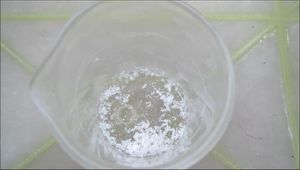Ammonium bisulfite
 |
This article is a stub. Please help Sciencemadness Wiki by expanding it, adding pictures, and improving existing text.
|
 NH4HSO3 crystals
| |
| Names | |
|---|---|
| IUPAC name
Ammonium hydrogen sulfite
| |
| Other names
Ammonium hydrogensulphite
Azanium hydrogen sulfite Sulfurous acid, ammonium salt (1:1) | |
| Properties | |
| NH4HSO3 | |
| Molar mass | 99.104 g/mol |
| Appearance | Colorless to yellowish solid |
| Odor | Poignant, sulfur dioxide |
| Density | 2.03 g/cm3 (at 20 °C) (72% aq. sol.) |
| Melting point | 50–60 °C (122–140 °F; 323–333 K) (decomposes) |
| Boiling point | 147–150 °C (297–302 °F; 420–423 K) (sublimes) |
| 71.8 g/100 ml (0 °C) 267 g/100 ml (10 °C) 620 g/100 ml (60 °C) | |
| Solubility | Reacts with HCl 37% Insoluble in toluene |
| Hazards | |
| Safety data sheet | Hydrite (70%) |
| Related compounds | |
| Related compounds
|
Ammonium sulfite |
| Except where otherwise noted, data are given for materials in their standard state (at 25 °C [77 °F], 100 kPa). | |
| Infobox references | |
Ammonium bisulfite is an inorganic compound, with the formula NH4HSO3. It is a pale yellow solid, which emits toxic sulfur dioxide fumes at standard conditions.
Contents
Properties
Chemical
Ammonium bisulfite will slowly oxidize in air to ammonium bisulfate:
- NH4HSO3 + ½ O2 → NH4HSO4
Addition of excess ammonia will give ammonium sulfite.
- NH4HSO3 + NH3 → (NH4)2SO3
Physical
Ammonium bisulfite is an unstable white-yellowish solid, soluble in water, which gives off sulfur dioxide vapors upon standing, giving it a very unpleasant odor.
Availability
Ammonium bisulfite is available as aqueous solution, though due to its hazards it's best to make it yourself.
Preparation
Can be prepared by bubbling an excess of sulfur dioxide through aqueous ammonia. Cooling the solution will cause crystals to precipitate.[1]
Projects
- Reducing agent
Handling
Safety
Ammonium bisulfite is irritant and toxic. Should be handled with proper protection, in well ventilated areas.
Storage
In closed bottles, away from metals, in well ventilated areas. Do not store for long.
Disposal
Can be neutralized with hydrogen peroxide to ammonium bisulfate and if necessary with excess ammonia to ammonium sulfate.
References
Relevant Sciencemadness threads
No threads so far. Why not start one?